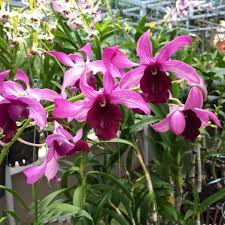# Tips for Keeping Dendrobium Orchids in Bloom Longer

Dendrobium orchids are celebrated for their stunning blooms and captivating beauty. Known for their vibrant colors and unique forms, these orchids can add elegance to any space. However, one common concern among orchid enthusiasts is how to prolong the blooming period of Dendrobium orchids. Understanding the needs of these orchids and applying specific care techniques can significantly enhance their flowering duration. This article will provide comprehensive tips for keeping Dendrobium orchids in bloom longer, covering aspects such as light, temperature, humidity, watering, fertilization, pest management, and repotting.
## Understanding Dendrobium Orchids
### Overview of Dendrobium Species
Dendrobium is one of the largest genera of orchids, with over 1,800 species. These orchids are native to a wide range of habitats, predominantly in tropical and subtropical regions of Asia and the Pacific. Dendrobium orchids are characterized by their unique pseudobulbs, which store water and nutrients, allowing them to thrive in various environments. Different species have varying requirements, making it essential for growers to understand the specific needs of the Dendrobium they are cultivating.
### Growth and Flowering Cycle
Dendrobium orchids typically have a defined growth cycle that includes a period of active growth followed by dormancy. Understanding this cycle is crucial for manipulating environmental conditions to prolong the flowering period. After blooming, Dendrobium orchids enter a resting phase where they need less water and nutrients.
## Key Factors for Prolonging Blooming
### 1. Light Requirements
**Importance of Light:**
Light is one of the most critical factors influencing the growth and flowering of Dendrobium orchids. These plants thrive in bright, indirect light. Insufficient light can lead to delayed flowering, while excessive direct sunlight may scorch the leaves.
**Optimal Light Conditions:**
– **Light Intensity:** Dendrobiums prefer bright, indirect light with around 50-70% shade. A south or east-facing window is ideal.
– **Duration:** Provide 12-14 hours of light per day. Supplemental grow lights can be used during the shorter days of winter to ensure sufficient light exposure.
**Tips for Providing Adequate Light:**
– Rotate the plants regularly to ensure even light exposure.
– Use sheer curtains to filter direct sunlight while allowing adequate light penetration.
– Consider using LED grow lights if natural light is insufficient.
### 2. Temperature Management
**Temperature Needs:**
Dendrobium orchids have specific temperature requirements that vary between species. Generally, they prefer daytime temperatures between 65°F and 80°F (18°C to 27°C) and slightly cooler nighttime temperatures of 55°F to 65°F (13°C to 18°C).
**Creating Temperature Gradients:**
– **Day/Night Variation:** A drop in temperature at night helps prolong the flowering process. Aim for a difference of at least 10°F (5°C) between day and night temperatures.
– **Seasonal Adjustments:** Use heaters or air conditioning to maintain optimal temperatures, especially during seasonal changes.
**Monitoring Temperature:**
– Use thermometers or digital temperature sensors to monitor conditions in the growing area.
– Adjust heating or cooling devices as necessary to maintain desired temperatures.
### 3. Humidity Levels
**Humidity Requirements:**
Dendrobium orchids thrive in high humidity, ideally between 50% and 70%. Low humidity can lead to dehydration and stress, which can negatively impact the longevity of the blooms.
**Maintaining Humidity:**
– **Misting:** Lightly mist the orchids in the morning to increase humidity without causing waterlogged conditions.
– **Humidity Trays:** Place trays filled with water and pebbles beneath the pots to create a microenvironment of increased humidity.
– **Humidifiers:** Consider using a humidifier in indoor spaces, particularly during dry winter months.
**Monitoring Humidity:**
– Use a hygrometer to regularly check humidity levels.
– Adjust misting or humidifier settings as needed to maintain optimal humidity.
### 4. Fertilization Techniques
**Importance of Fertilization:**
Proper fertilization is crucial for promoting healthy growth and prolonging flowering in Dendrobium orchids. The right nutrients can enhance flower production and support overall plant health.
**Fertilization Schedule:**
– **Growing Season (Spring/Summer):** Use a balanced fertilizer (e.g., 30-10-10) every 2-4 weeks during the active growing season to encourage robust growth and flower development.
– **Pre-Bloom Phase (Late Summer/Early Fall):** Switch to a high-phosphorus fertilizer (e.g., 10-30-20) to stimulate blooming. Apply this every 2-4 weeks leading up to the anticipated bloom time.
**Application Techniques:**
– Dilute liquid fertilizers according to manufacturer instructions to prevent root burn.
– Apply fertilizers during regular watering to ensure even nutrient distribution.
### 5. Watering Practices
**Watering Needs:**
Proper watering practices are essential for the health of Dendrobium orchids. Overwatering can lead to root rot, while underwatering can cause dehydration and stress.
**Watering Schedule:**
– **Growing Season:** Water more frequently during the growing season, allowing the medium to dry out slightly between waterings.
– **Dormant Phase:** Reduce watering during the dormancy period, only providing enough moisture to prevent complete desiccation.
**Water Quality:**
– Use distilled or rainwater to avoid mineral buildup from tap water, which can harm the orchids.
– Ensure pots have adequate drainage to prevent water accumulation.
### 6. Pest and Disease Management
**Common Pests:**
Pests such as aphids, mealybugs, scale, and spider mites can stress orchids and hinder blooming. Regular inspection is crucial for early detection and treatment.
**Integrated Pest Management (IPM):**
– **Cultural Controls:** Keep the growing area clean and free of debris to reduce pest habitats.
– **Natural Predators:** Introduce beneficial insects like ladybugs to control pest populations naturally.
– **Insecticidal Soaps:** Use organic insecticidal soaps or neem oil to treat infestations.
**Disease Prevention:**
– Avoid overhead watering to reduce the risk of fungal diseases.
– Ensure good air circulation around the plants to minimize humidity-related issues.
### 7. Repotting and Potting Medium
**Repotting Needs:**
Choosing the right potting medium and repotting at the right time is essential for the health and blooming of Dendrobium orchids. A well-draining medium prevents waterlogging and encourages healthy root growth.
**Recommended Potting Medium:**
– Use a mix of bark, perlite, and sphagnum moss to provide aeration and drainage.
– Consider specialized orchid potting mixes available at garden centers.
**Repotting Practices:**
– Repot every 1-2 years or when the medium breaks down to maintain proper aeration and drainage.
– Choose a pot that allows for root expansion while providing stability.
### 8. Environmental Considerations
**Creating the Ideal Environment:**
To prolong the blooming of Dendrobium orchids, it is essential to create an environment that meets their specific needs.
– **Air Circulation:** Ensure good air circulation around the orchids to prevent mold and pests. A small fan can help maintain airflow in indoor settings.
– **Avoiding Sudden Changes:** Minimize sudden changes in temperature and humidity to prevent stress and encourage longer bloom duration.
### 9. Seasonal Considerations
**Seasonal Care Adjustments:**
Understanding seasonal changes and adjusting care routines is vital for prolonging flowering.
– **Spring and Summer:** Focus on providing adequate light, humidity, and fertilization to encourage growth and extend the blooming period.
– **Fall:** Begin transitioning to higher phosphorus fertilizers to prepare for blooming. Gradually reduce watering as temperatures cool.
– **Winter:** Maintain a cooler environment to simulate natural dormancy while ensuring adequate light and humidity.
### 10. Triggering Longevity in Blooms
**Stress Techniques:**
While not always recommended, some growers use stress techniques to encourage prolonged blooming. These may include slight reductions in watering or temperature changes, mimicking natural environmental fluctuations that can trigger longer bloom cycles.
**Observation and Patience:**
– Monitor plant responses closely to avoid causing undue stress that could harm overall health.
– Be patient; the process of prolonging blooms takes time and may not occur in every growing cycle.
### 11. Encouraging Flower Spike Development
**Understanding Flower Spike Development:**
The development of flower spikes is a critical stage in the blooming process. Ensuring that your Dendrobium has the right conditions to produce flower spikes will ultimately lead to longer-lasting blooms.
– **Nutrient Boost:** Provide additional potassium and phosphorus during the flowering phase to support spike development.
– **Pruning Techniques:** Prune spent flower spikes to encourage new growth and prolong overall bloom duration.
### 12. Post-Bloom Care
**Caring for Dendrobium After Blooming:**
Once the blooms fade, proper care is essential to ensure the plant remains healthy and ready for the next blooming cycle.
– **Light Adjustment:** Gradually reduce light exposure as the plant enters its dormant phase.
– **Watering and Feeding:** Scale back watering and fertilization until new growth appears, indicating that the plant is ready to bloom again.
### Conclusion
Keeping Dendrobium orchids in bloom longer requires a comprehensive understanding of their needs and growth cycles. By carefully managing factors such as light, temperature, humidity, fertilization, watering, repotting, and pest control, growers can successfully enhance the longevity of these stunning plants.
With dedication and attention to detail, you can enjoy the beauty of Dendrobium orchids in full bloom for an extended period. By following these tips, you will create the ideal environment for your Dendrobium orchids to flourish, ensuring that their captivating blooms bring joy and elegance to your home
for months on end.
Whether you are a seasoned orchid enthusiast or a novice gardener, applying these strategies will not only enhance the beauty of your Dendrobium orchids but also contribute to their overall health and vitality. Happy growing!

